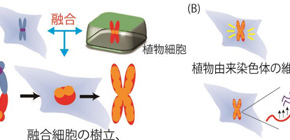
Successful partial hybrid cells of humans and plants
A first step toward the clarification of life principles conserved beyond 1.6 billion years of evolution
It is thought that plants and animals were diverged from common ancestors about 1.6 billion years ago and evolved in their own way, respectively. However, it was unknown how much functions of their own are conserved in their long history.
Specially Appointed Assistant Professor WADA Naoki at the Graduate School of Engineering, Osaka University, under the guidance of Professor OSHIMURA Mitsuo at the Chromosome Engineering Research Center, Tottori University, together with Visiting Professor FUKUI Kiichi at the Graduate School of Pharmaceutical Sciences, Osaka University, succeeded in developing hybrid cells, although a partial one, between humans and plants, a world first. This group also clarified that plant chromosomes are stably maintained and that genes of various plants were expressed in these hybrid cells with a background similar to a human background.
This group discussed conditions and methods for fusing thale cress (a model plant)-derived cells and human cells, succeeded in obtaining partial hybrid cells between humans and plants. The whole human chromosomes were conserved in these hybrid cells, so it is thought that these hybrid cells had a cell environment similar to humans’. Human-Plant Chromosomes with plant chromosomal regions were observed in these hybrid cells.
Furthermore, this group found that the structure of Human-Plant Chromosome changed during culture, and formed independent plant chromosomes with plant chromosomes translocated. As these plant chromosomes were stably maintained, a mechanism for conserving human chromosomes worked in plant chromosomes as well, and these Human-Plant Chromosomes conserved various plant chromosomes as they had been.
After examining expression of the gene in full detail, this group confirmed that various plant genes were expressed in these hybrid cells. This shows that gene expression systems are conserved between humans and plants. In other words, the encounter of chromosomes in human and plants first in the some 1.6 billion years in this study demonstrated that living organisms still had a mechanism for conserving their chromosomes and a mechanism for expressing genes. This suggests that these systems are very fundamental and important for life.
Hybrid cells established by this group is the first tool for enabling the examination of evolutionary conservation between humans and plants at the chromosomal level. The use of these cells will be helpful in finding out basic principles of life, or how living organisms have evolved and what natures they have remained.
Additionally, generating new species in plants and microorganisms by introducing different genome and chromosomes is thought to be a very promising breeding method. In order to use this method at will, it is necessary to know how different genomes and chromosomes are accepted in living organisms and cause stability or instability.
It is expected that hybrid cells developed by this group will be helpful in the clarification of a general chromosome maintenance mechanism beyond species, contributing to the breeding of living organisms that can be beneficial to humans.
Abstract
Replication, segregation, gene expression, and inheritance are essential features of all eukaryotic chromosomes. To delineate the extent of conservation of chromosome functions between humans and plants during evolutionary history, we have generated the first human cell line containing an Arabidopsis chromosome. The Arabidopsis chromosome was mitotically stable in hybrid cells following cell division, and initially existed as a translocated chromosome. During culture, the translocated chromosomes then converted to two types of independent plant chromosomes without human DNA sequences, with reproducibility. One pair of localization signals of CENP-A, a marker of functional centromeres was detected in the Arabidopsis genomic region in independent plant chromosomes. These results suggest that the chromosome maintenance system was conserved between human and plants. Furthermore, the expression of plant endogenous genes was observed in the hybrid cells, implicating that the plant chromosomal region existed as euchromatin in a human cell background and the gene expression system is conserved between two organisms. The present study suggests that the essential chromosome functions are conserved between evolutionarily distinct organisms such as humans and plants. Systematic analyses of hybrid cells may lead to the production of a shuttle vector between animal and plant, and a platform for the genome writing.
Figure 1. A hybrid cell line between human and plants.(A) Human and plant cells were fused and the hybrid cells containing a plant chromosome were obtained.
Initially, the plant chromosome was maintained as a translocated chromosome to human chromosome 15. During the cell cultures, the chromosome structure changed, resulting in the formation of independent plant chromosomes consisting of only plant DNAs (Red; plant chromosome, Blue: human chromosome). (B) Our study indicated that the plant chromosome can be maintained independently (Upper), plant genes can be expressed (Bottom) in human cell background.
To learn more about this research, please view the full research report entitled “ Maintenance and Function of a Plant Chromosome in Human Cells ” at this page of the ACS Synthetic Biology website.
Related link
